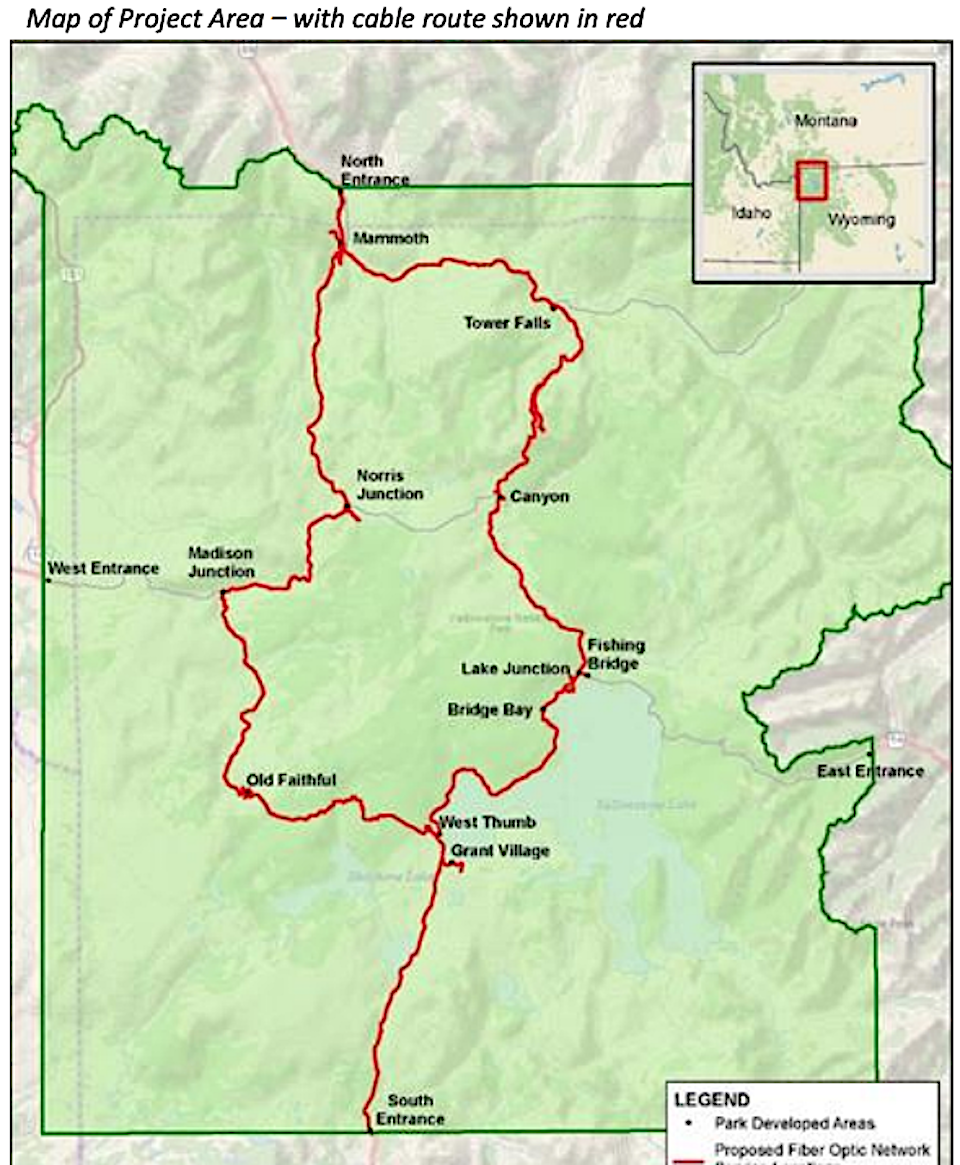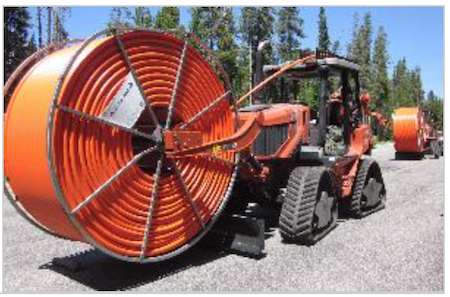
Yellowstone officials are seeking public comment on a proposal to bury fiber optic cable throughout most of the park's main road system/NPS file
Nearly 200 miles of fiber optic cable would be buried through Yellowstone National Park under a proposal officials say would improve cellphone coverage and reliability while also allowing for the removal of "antiquated telecommunication systems currently on mountain tops and from the backcountry."
The proposal, now open for public comment, stems from an application for a right-of-way permit from Diamond Communications, LLC. According to the park, if approved the company could:
-
Install fiber-optic cable along 187 miles of park roads.
-
Use "appropriate" equipment e.g., rubber-tracked vehicles, to install the conduit underground within the existing road corridor, immediately adjacent to and/or directly into the roadbed.
-
Initiate temporary and localized traffic restrictions and speed reductions in work areas from April until early November for three consecutive years.

Rubber-tracked vehicles would be used to lay the cable/NPS
If approved, construction could begin as early as 2021.
Installation of the cable would allow for removal of five microwave radio reflectors that were installed in the park’s backcountry around 1980. Removal could begin in the near future. Currently, these reflectors are an essential component of the park’s microwave radio telecommunication system.
The existing microwave radio system is the only means of telecommunication (telephone, 911 and computer networks) to the park.
Additional proposal details, according to the park, include:
-
It is estimated that 8 percent of the park is currently covered by cellular.
-
The proposal would not expand authorized cellular phone coverage areas in the park, but would substantially improve coverage quality in existing developed areas.
-
This proposal is consistent with Yellowstone National Park’s Wireless Communications Services Plan.
-
No new cellular towers would be installed under this proposal.
-
Diamond Communications, LLC. would pay for all of the up-front construction costs.
-
Once installed, Yellowstone National Park could subscribe to the broadband services.
-
Commercial telecommunication systems can be considered a utility and, like other utilities, are authorized on NPS lands using the right-of-way permit process.
The proposal addresses the following park issues:
-
Existing bandwidth on the existing microwave radio system is inadequate and no longer meets the park’s needs for business operations, employee communications, and emergency communications and operations.
-
Due to extremely remote duty stations, recruitment/retention for both the NPS and its business partners is severely affected by a lack of consistent and reliable connectivity.
If this proposal is approved, the benefits to NPS staff, partners and visitors would include:
-
Improved telephone, cellular phone, park computer networks and broadband internet services that could meet critical park operations, safety and emergency services and visitor information needs and expectations in developed areas.
Following this comment period, an environmental assessment will be prepared to analyze the proposal and its impact on the environment. The EA will comply with the National Environmental Policy Act, Section 106 of the National Historic Preservation Act and other applicable laws and regulations. The NPS will release the EA for public review before making a final decision about the proposal. The EA is scheduled to be completed in winter 2021.
Comments must be received by October 21, 2020. Comments may be submitted online at: https://parkplanning.nps.gov/fiber or by mail. Comments will not be accepted by fax, email, or other means. Mail comments to: Compliance Office, Attention: Fiber Optic Project, P.O. Box 168, Yellowstone National Park, Wyoming 82190.



Comments
According to the article, this "proposal would not expand authorized cellular phone coverage areas in the park" and, at least to the best of my understanding, that provision would be a convenient adjunct to claiming that "No new cellular towers would be installed under this proposal." I have a lot of NEPA experience. Again to the best of my understanding, I believe the decision to limit the current proposal to just the installation of the telecommunications infrastructure along the existing roadways, along with weaving those two seemingly innocuous provisions into the description of the proposal, may actually reflect an effort to improperly "segment" this federal action in order to dampen and, in effect, evade public response and thereby get this proposal approved on the basis of a less rigorous "Environmental Assessment" (EA) resulting in a "Finding Of No Significant Impact" (FONSI) and tiered to the park's existing Wireless Communications Services Plan and existing right-of-way permit process rather than opening the door to a more rigorous and complete "Environmental Impact Statement" (EIS) and the more detailed and forthcoming "Record Of Decision" (ROD) that might result from that process.
I believe that, viewed from a more strategic perspective, consideration of the installation of this telecommunications infrastructure along existing roadways in the park cannot and should not be isolated from nor, in NEPA terminology, "segmented" from the full suite of opportunities for further development, future proposals, and more extensive projects that it offers. Diamond Communications and the NPS, with current Park Superintendent Sholly pulled along in tow, might want the public to think that this proposal involves no new cellular towers and no expansion of authorized cellular phone coverage; but, anyone who can eat oatmeal with a spoon has to recognize that the installation of this telecommunications infrastructure will inevitably set the stage for and practically guarantee new cellular towers and expanded cellular phone coverage in the foresseable future. The NEPA examination of this current telecommunications infrastructure should honestly and honorably address and discuss the obvious potential further development that it will enable and the ultimate "cumulative impacts" of that further development rather than be "segmented" in such a way that evades such a discussion.
Now, please don't jump to the conclusion that I oppose this proposal, oppose any and all new cellular towers, and oppose any and all expanded cellular phone coverage. I do not. In fact, if the installation of this telecommunications infrastructure along existing roadways can enable the removal of existing, obsolete and hard to maintain, backcountry equipment and sites and eliminate intrusive backcountry maintanance activities as a result, then I support it, even if it ultimately leads to the construction of additional towers and expanded phone coverage along the already crowded roads and in the already congested sites in the front country. What I firmly oppose is any additional dishonesty or dishonorable behavior on the part of the NPS and their entrenched associates in the park.
So, if I don't actually oppose the proposal, then, aside from greater rigor, detail, and honesty that a proper NEPA process might provide, what is the point? Well, America was built on democracy and our democracy was built on laws that guarantee equity and due process. The NEPA process is due process at its best, one of the fundamental pillars of our environmental laws, and one that the NPS, of all agencies, should be devoted to properly following and scrupulously maintaining.
Yellowstone is justifiably famous for many wonderful things. Let's stop this recent trend toward making it also infamous for crooked nonprofits, savagely greedy concessionaires, and an NPS that either looks the other way or acts as an active enabler.
So NEPA has to look at potential future developments that are not currently proposed nor authorized by the current project. That seems like a long stretch. Reminds me of "if you give a mouse a cookie".
Seems pretty innocuous to me, and the park installations could use a communication upgrade.
Do it. Witnessed a bad accident in the park back in August. No cell service to report it, or call LEO. All parks should make use of all the 21st century technology available. Trying to have them operate in today's world with 1930's equipment is ludicrous.
I was a first time visitor this fall. I used a first come, first serve campsite. It would be helpful if there was a data screen at each location, showing in real time the occupancy and availability of sites at each campsite. A fiber connection project would be helpful in creation of such a system. I would support this upgrae.
yours,
Douglas Lee
[email protected]